
PREV ARTICLE
NEXT ARTICLE
FULL ISSUE
PREV FULL ISSUE
COPERNICUS'S TREATISE ON MONEYGosia Fort submitted this article on Nicolas Copernicus as a numismatist and his famous treatise on money. Thanks! -Editor Earlier this fall I gave a presentation on Mikolaj Kopernik (Nicolas Copernicus) as numismatist to the Western Pennsylvania Numismatic Society. Copernicus is probably one of the most famous Poles, known to the world as the astronomer and the author of the work on the heliocentric theory of the world De revolutionibus orbium coelestium (On the Revolutions of the Heavenly Spheres). However, his skills and interests went beyond astronomy. He was a man of the Renaissance, fluent in many languages, with degree in canon law, who also was a physician, translator, artist, scholar, economist, mathematician and diplomat.
He wrote several works dealing with economics and finance, but none of them were published during his life time. My talk focused on Copernicus's treatise on money, of which three different versions are known. No originals survived. All of them are known only from the later copies. The earliest version Meditata (1517) includes the idea that bad money is driving out good money. Later this monetary principle – known as Gresham Law – was popularized by the English merchant and named after him. Not many people know though, that when Copernicus formulated the idea that bad money is driving out good money Thomas Gresham has not been born yet. The second version,
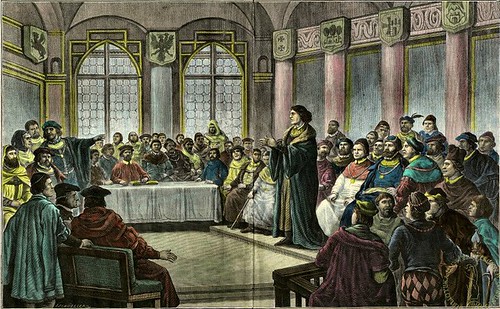
19 cent. Drawing by Johan Schübeler of Copernicus presenting in Grudziadz
The final version Monete cudende ratio (On the minting of coin, 1526) presented quite a detailed analysis of the debasement process in relation to Prussian coinage and added a new passage in which he stated that the relation between the nominal price (face value) of silver and gold coins should be identical with the price of pure silver and gold. For more information I refer everyone to an excellent website on Copernicus created at the University of Torun, especially to the section on economics prepared by Leszek Zygner
I illustrated this talk with medals and coins from my collection which directly refer to Copernicus's presentation in Grudziadz or his treatise on money:
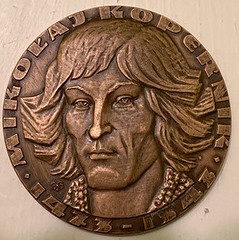
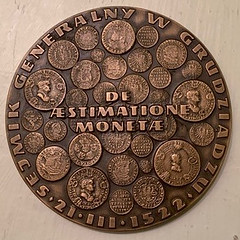
1972 – Bronze medal commemorates the Assembly in Grudziadz on the 450 anniversary of the Copernicus visit to this city. The artist Edward Gorol included in his design Polish coins of the period and the title of the work (De aestimatione monetae also known as Meditata).
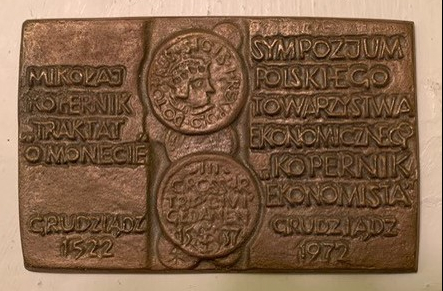
1972- One-sided bronze plaquette struck for the Symposium of Polish Economics Society devoted to Copernicus as economist and held in Grudziadz 1972 to celebrate 450 anniversary of Copernicus giving his presentation on money.
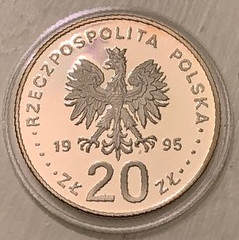
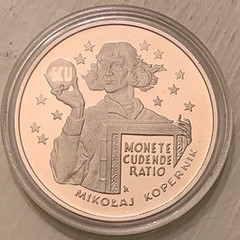
1995 - 20 ZL silver coin designed by Robert Kotowicz with obvious references to Copernicus economic interest: Copernicus is holding the ECU coin in one hand and his book on coinage in the other
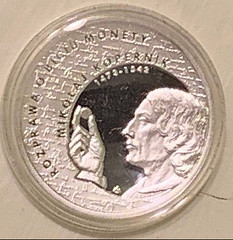
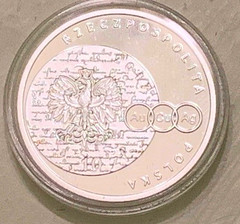
2017 - 10 ZL silver coin designed by Sebastian Mikolajczak with Copernicus examining a coin, the common title (Treatise on money) spelled out on left and the manuscript of his treatise in the background.


1973 – Bronze medal issued by Polish Society of Archeologists and Numismatists to celebrate 500 anniversary of Copernicus birth recognizing his contribution to the study of coins by including images of the coins from the period. I added also several medals with Copernicus issued by different numismatic societies, events, exhibits or collections, and ended with images of medals from my wish list, which are also tied to Copernicus and his interest in money.

Wayne Homren, Editor The Numismatic Bibliomania Society is a non-profit organization promoting numismatic literature. See our web site at coinbooks.org. To submit items for publication in The E-Sylum, write to the Editor at this address: whomren@gmail.com To subscribe go to: https://my.binhost.com/lists/listinfo/esylum All Rights Reserved. NBS Home Page Contact the NBS webmaster 
|